I had The Spooks something serious. After a mostly sleepless night in Galveston of nervous tossing and turning, Stephanie and I got up early, at 4:30am. This gave me about three hours before the start, and I had a quick bite to eat. She dropped me and my gear off as close as we could get to the start, about a mile from the transition area. Myself and a long line of sleepy people lugged our gear through the darkness to setup our gear. We each had about a foot on each side of our bike to try to download everything from our gear backpacks. An overly cheerful announcer and DJ kept everyone up to date about upcoming start times and where we should be.
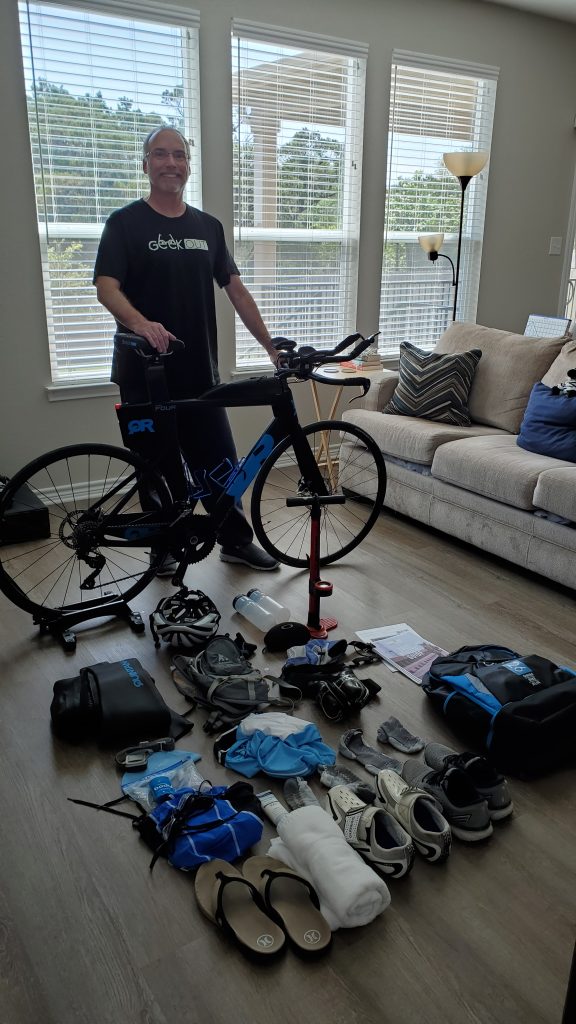
The event had over 2,500 people signed up, but only about 2,000 showed up in Galveston. Still, that was more than enough people to keep the lines at the porta-potties quite long. One of my really good decisions for the day was lining up at the porta-potty for a last download before putting on my wetsuit.
There are some people that were chatty and upbeat, but I honestly had a severe case of The Spooks. I could see the same in some of the other athletes: dilated pupils and a blank look on their face. The Spooks makes it so your IQ drops to about the outside temperature and you just can’t think clearly. I triple checked my gear against my pre-written checklist. We had all trained for 6 months or more for this moment, and put in a lot of time and pain to get our bodies here. I was pretty sure I would finish, but I knew from my training how much pain I was about to subject myself to. Would my training be enough? Would I finish? Or be in the hospital in 8 hours?
I chatted with the guy next to me who casually mentioned that this was his fifth Ironman. It seemed like everyone around me looked fitter, had a faster bike, or had already done a race like this multiple times. I did a little deep breathing to relax, did a quick reflection on all my training, and started peeling on my wetsuit. Lots of pre-race thoughts are flying around: Is the water too cold? I haven’t even started, how come my knees hurt? Do I have to go to the bathroom again? Should I use my clear or polarized goggles? Is the wind going to be bad today on the bike? Where did I put my race number? Oh, there it is right where I put it: under my water bottle so it won’t blow away.
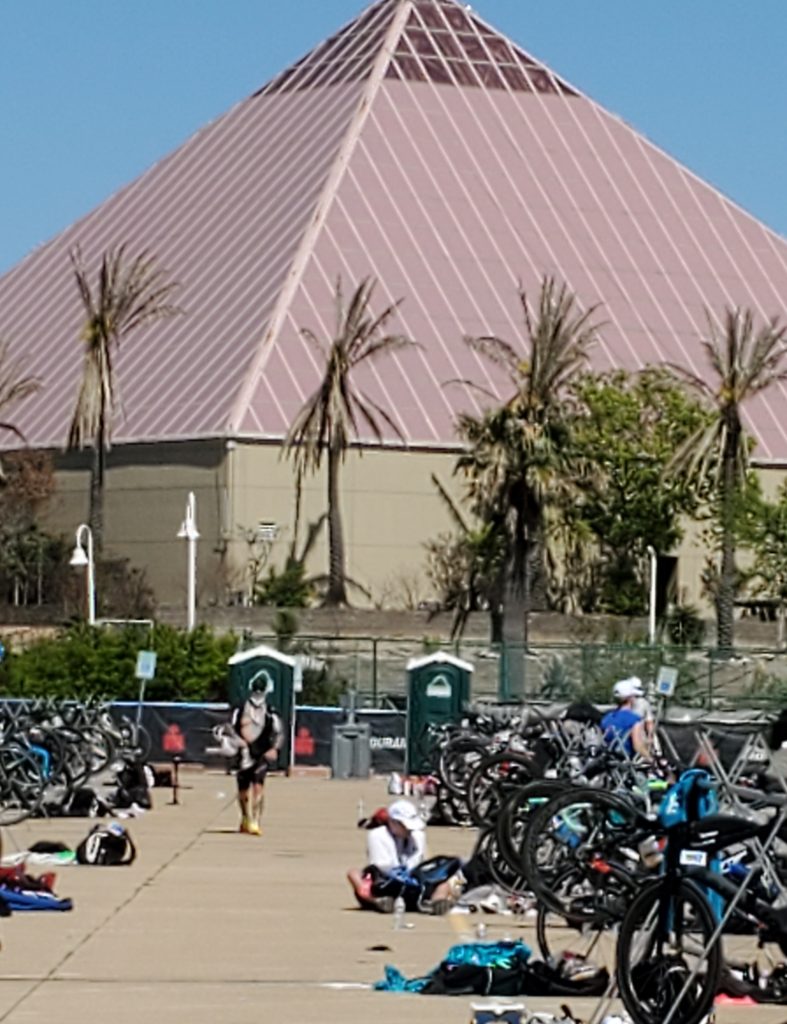
The announcer was sorting us into start groups by calling out estimated finish times for the swim. The fastest swimmers get into the water first to avoid too much pile-up. The fastest swimmers do the swim in about 24 minutes. When I heard the 45-minute slot, I walked over to the edge of the transition area with the other swimmers and waited. Then a volunteer holding a sign that said “42-46 minutes” led us off for the half mile walk to the swim start. We got about 50 yards and then stopped. There must have been about 1,000 other swimmers in front of us standing in line. A cannon periodically shot off to announce a start, but at the back of the line we really had no idea what was happening. We would wait 10 minutes, move forward about 20 yards, and then wait again.
My group eventually got close to the start line and we threw away our flip flops and Covid masks. Swim cap and goggle check, and then start the walk to the end of one of the three start piers. At the end of the pier, a race staff member marks down your number and starting time. The start horn goes off every 5 seconds, and when it is your turn, you jump off the end of the pier. That is 40 people per minute piling into the water, with many of them having to stop and adjust their goggles or catch their breath. Imagine filling a neighborhood pool with 200 people and then trying to swim across it.
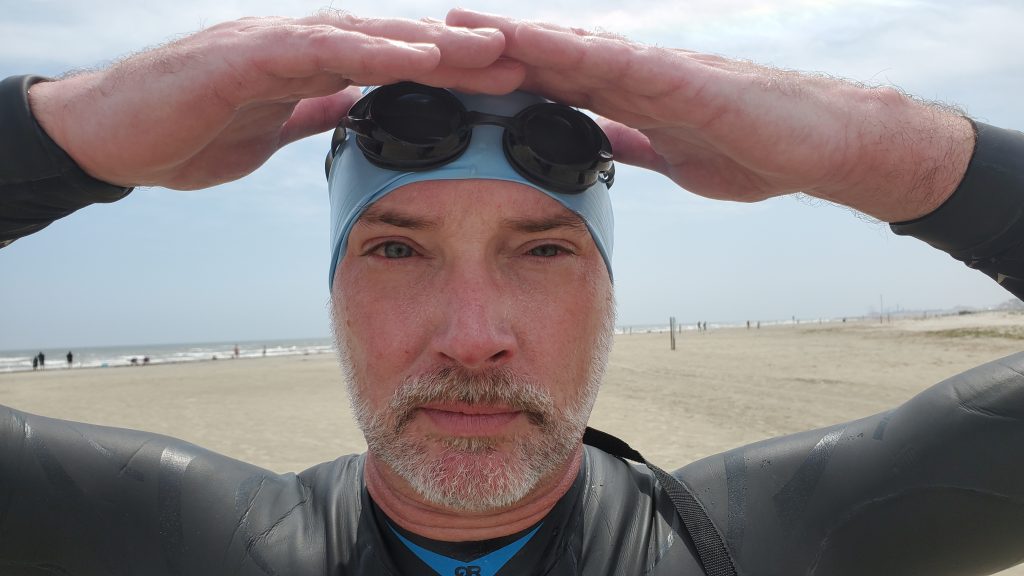
I jumped in and bobbed back up. The water was warm and actually pretty comfortable. There was a mass of 100 people trying to swim up and around the first swim buoy. The buoys look like giant floating Hershey kisses, but red. I got kicked a few times, but managed to swim around a lot of the others to make it past the first turn. Other swimmers, after the race, mentioned the swells and the chop and the difficult swim. For me, the water was easy. Getting around or through all the other people was difficult.
The open water swim is by far what causes the most fear among athletes. It is only about 20% of the time and energy needed for the entire race, but 80% of the nerves. At the start you can see nerves playing out. Peoples’ eyes are opened wide but with pinprick pupils – they have the Spooks. There is nervous chatter. I try having conversations with a few around me to keep myself calm. By the end of the swim, 27 people had either missed the cutoff time or had swam over to a kayak and elected to pull out of the race.
Luckily, the swim has always been fun for me and I enjoy the chance to get out in open water. The middle of the swim was my favorite part. I got a clear straight stretch and I swam farther out from the buoys. This let me avoid the crowd and maintain a decent stroke rate. “Holy cow, I just started an Ironman!” I thought. Then the final turn around a buoy and back into the exit shoot. I managed to jockey for position in the crowd as we were directed into a single person wide exit ramp. I got my legs working again, and I went up the ramp without drama.
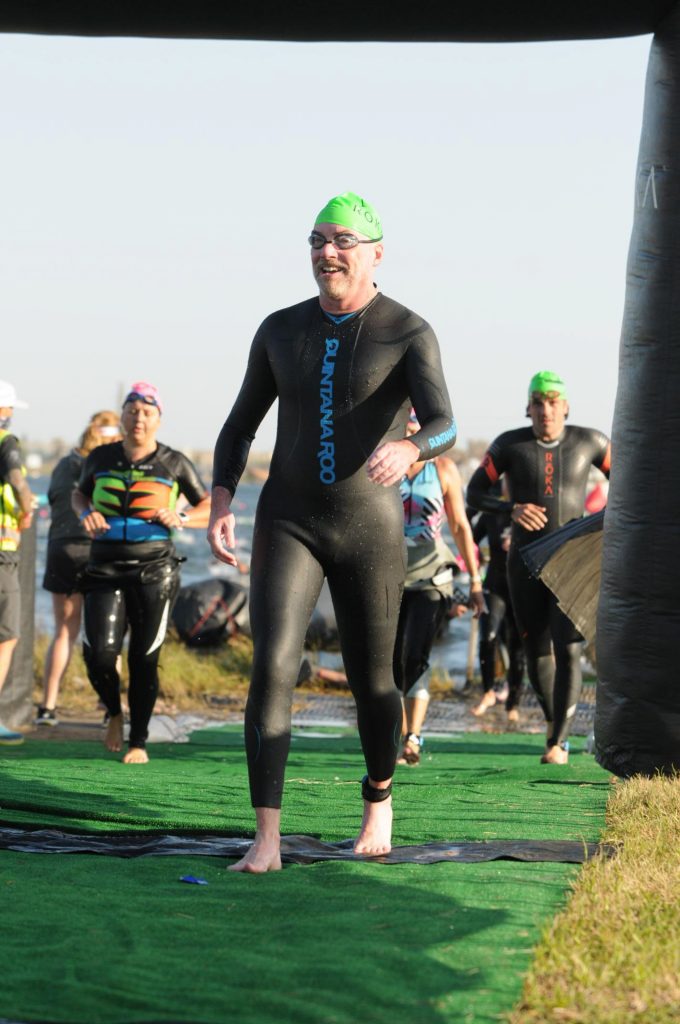
We helped each other with our wetsuit zippers. While others were running for time, I walked to my transition area to gear up for the bike. Like I had practiced multiple times: strip off the wetsuit, dry exposed skin, add sunscreen, biking shirt, socks, gloves, helmet, pull the bike off the rack and head toward the bike start. While others are running past me and jumping onto their bike, I stay cautious. No need to drop my bike here or rush. I go to the side and slowly put on my bike shoes, get clipped in, start the bike computer, and start peddling.
The start of the ride meanders through the resort’s streets and then turns onto the Seawall highway. I keep my power low, trying to stay at about 120 watts. If I burn up too much energy here, I won’t have it later. Out onto the highway, we have 28 miles to go before the turn around. I usually cruise at about 18 mph, but my speed is registering high, about 22 to 24 mph. Am I going too fast? It is flat, so it can’t be a hill. Must be: tailwind! This is bad. It means the first half will be fast, then the haul back will be slow and painful. I start into my energy drink as I ride and nibble on a power bar. Faster bikers pass me almost continuously, but I am enjoying the day!
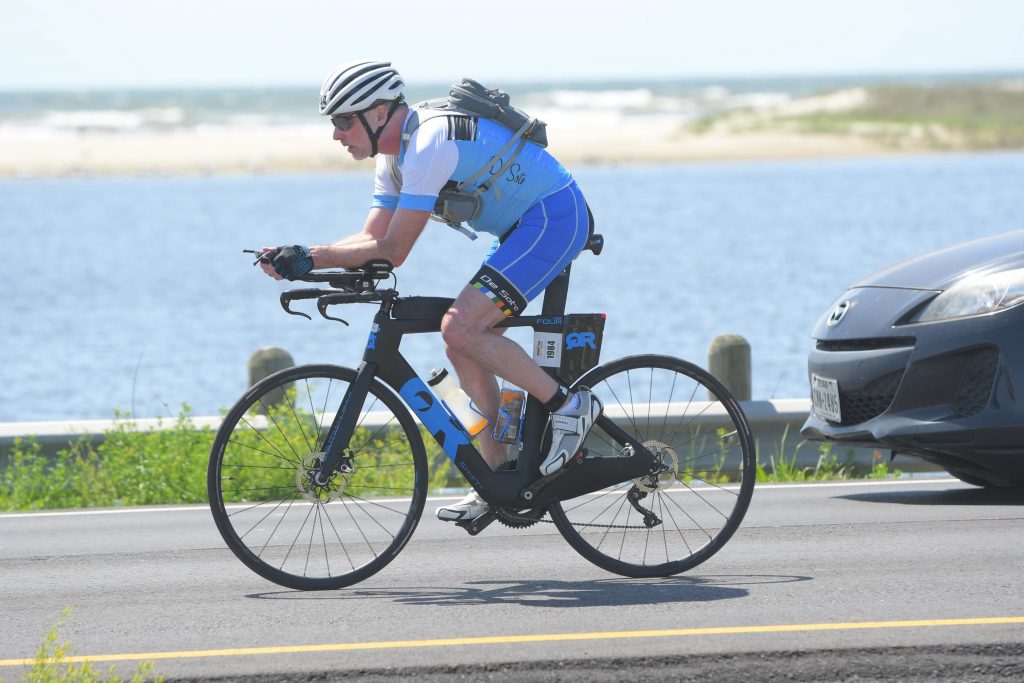
I see a bike down on the side of the road ahead of me. As I pass it, I see a male lying out on the ground with some medical people around him. Looks like a body thing, not a crash. The road is not completely closed to cars, but we do have about ½ lane that is reserved for us. After the race I will learn of at least four people that had to be hospitalized; two from bike crashes and two were hit by cars turning into their lane. One guy got hit by a car and had a broken rib, separated shoulder, and lost one of his handlebars. He kept riding and managed to finish the race. He is much tougher than me!
Everything went fine until the turn around. I immediately felt the wind. My speed dropped down to 7 mph even though I was pushing 140 watts. I did some quick mental math and realized that there was no way I could put down this much power and finish the race. I couldn’t even reach down for my water bottle; it was taking both hands to control the bike with the wind gusts. The wind died down slightly and I was able to get up to 12 mph. I was in serious pain. My legs hurt, my back ached. It had taken a bit more than an hour to fly out here with the tailwind. It was going to more than two hours of uninterrupted pain for the return trip.
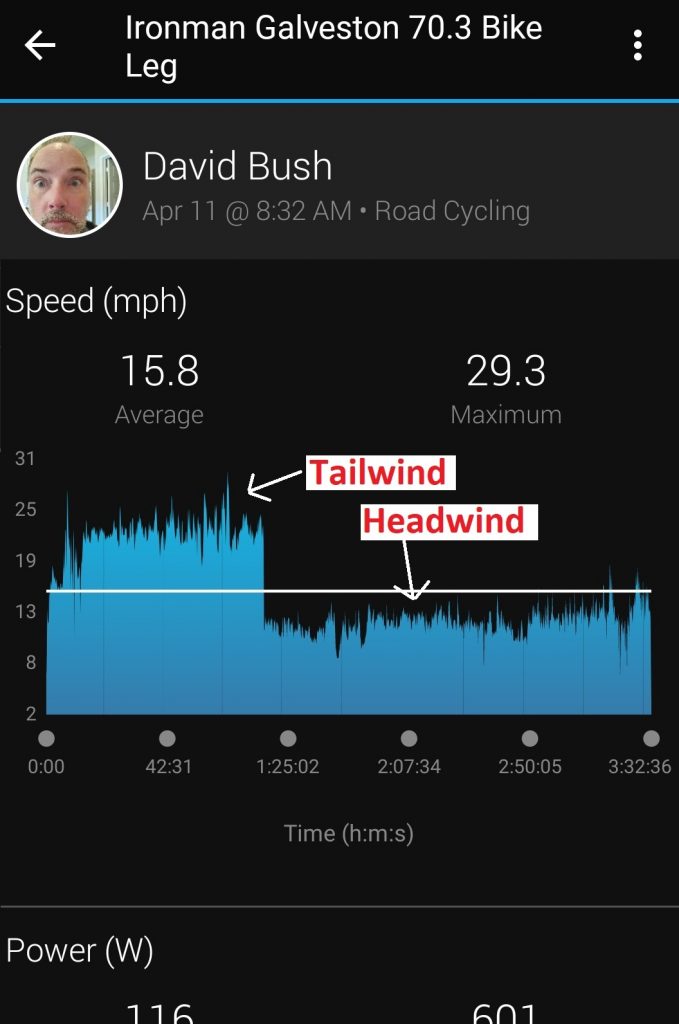
When I started triathlon training, I read articles and saw websites about athletes’ indoor training areas. The basics include: a treadmill, multiple indoor bikes, weights, loud music and motivational posters. Some even have an endless pool in their garage. Regardless of the gear, that area always has the same name. The Pain Cave. It is where you go to work out and to put in the time and the pain needed to get to race day. Today, making slow progress into the headwind, I realized that the Pain Cave is not the training area. The Pain Cave is what is within your head. By training, we discover how to accept the negativity, fear, doubt and pain and move on. The pain is still there, it is how you respond. The Pain Cave is in your head.
I reminded myself “I elected to be here. I am doing this for me. The course did not cause this pain, I am here by choice.” I could quit at any time. Or I could keep going. On a personal note, my sister passed away two months before this event. She had died a slow death from alcoholism. That is a bitter road that takes an enormous amount of self-discipline and support to overcome. She did not make it. I decided that there was no way I was going to quit. I kept riding on the road I had chosen to be on. I settled into the pain.
Mark Allen quote: “Until you face your fears, you don’t move to the other side, where you find your power.”
Riding back into town, I had to find a way. I knew with all my heart that I could not ride like that for two hours. So, I kept going for two minutes. Then I rode up to the water tower. Then I drank some more fuel. Then two more minutes. I can always do two more minutes. I would ride for a minute out of the saddle, I would speed up a bit and then coast. I would ride up till that palm tree in the distance. Then just two more minutes. Cyclists continued to pass me, but I found this actually encouraging. I felt happy for them, they are totally nailing this course!!
The miles added up slowly, and I eventually got back into town and started into the resort area. The wind slacked off as I passed a local Brew Pub. Cool! Location marked for tomorrow. Stephanie had grabbed a parking spot beside the bike course and done some quick calculus between the Ironman Tracker app and my estimated splits and caught some good camera shots of me on the way back in.
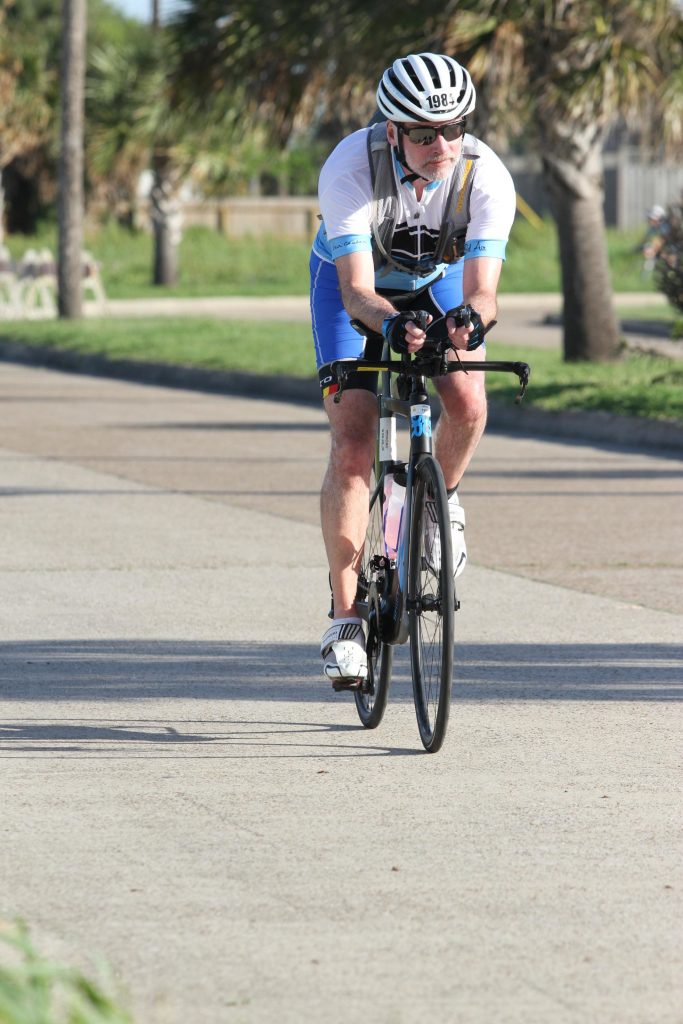
Transition ahead, “dismount before the line” a volunteer said, so I did. I walked back to my transition spot with other tired athletes and wearily started changing gear for the run. After hard exertion, sometimes blood will stay in your limbs and muscles, and the blood will have a hard time coming back to your core. Side effect: I was getting a little dizzy. Luckily, I had experienced this in training, so I kept moving, got some more nutrition, and then took an extra two minutes to change out of my Tri shorts and into running shorts – totally worth it!!
I managed a slow jog out of transition and then settled into a mostly walk, sometimes run half marathon. The dizziness faded. There were a lot of water/energy stations, so I started downing more Gatorade Endurance, cold water, and the occasional Red Bull. I walked with other athletes and we discussed the course and how we were feeling.
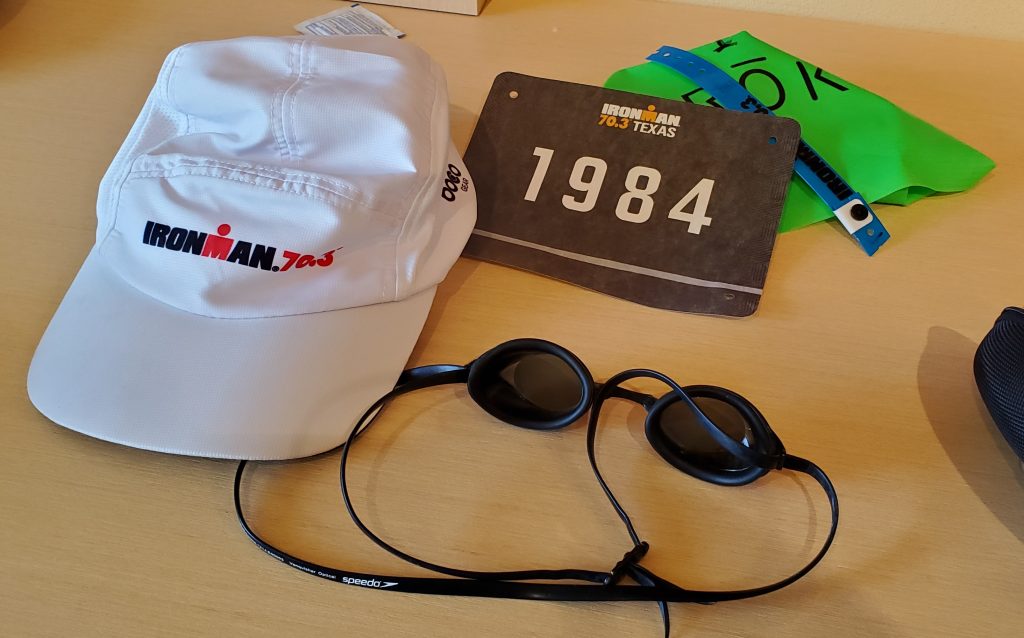
I walked for a bit with an athlete that must have been about twice my size. He was running awkwardly and appeared to be in a lot of pain. We chatted about the course and commiserated about how bad we were feeling. I would catch up to him and we would talk, and then he would run ahead bit. We passed back and forth a few times playing cat and mouse. He kept going a bit faster than me and eventually pulled ahead out of sight. We actually saw and recognized each other after we had both finished and did a quick fist bump celebration.
Many people get caught up in the competition, the splits, and getting a PR. For me, I purposely left my ego behind. I was here to finish, and if I had to walk, that was fine with me. Quick math showed that if I did a fast walk, I would still finish an hour before the cutoff time. I would walk and let my body build energy, and then run for a bit. I would build my run up to my normal pace and go into the Pain Cave for a bit. I was pretty proud – my pace was faster than those around me, even if I could not sustain it. Nothing that training can’t fix. Then more walking.
The Mile 10 marker came and me and the athletes around me did a mini-celebration – only a 5k to go! I ran up to another athlete that looked a bit younger and in better shape than me and dropped into a walk. “How are you doing?” I asked. He looked at me with a blank startled look and didn’t really say anything. I ran ahead a bit more. Everyone is doing their own race today: inside their head.
I got to the Mile 12 marker and a man walking beside almost started crying and said “that is the most beautiful number in the whole world right now.” One mile to go.
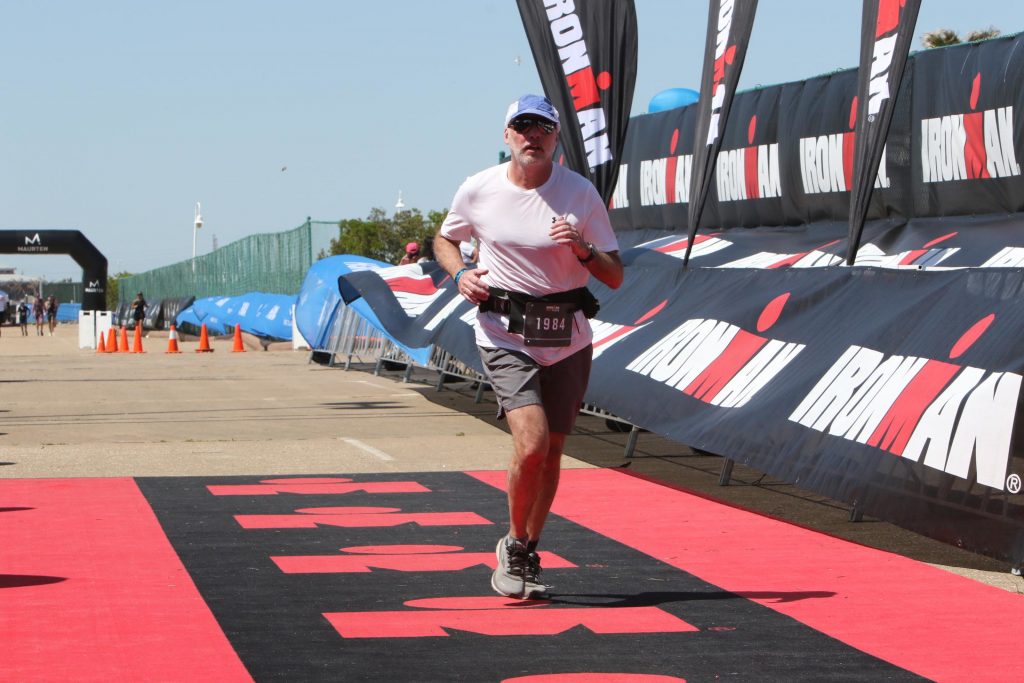
There was a long straight away to the finish line, so I ran a bit till there was a good gap between me and those ahead of and behind me. Got to set myself up for the Finisher Picture! I picked it up into a run about 50 yards from the line, this was going to be awesome. Wait, wait, oh crap! Cramp in my right calf. Please, please, please do not make me crawl across the line. Shake it out a bit, OK, I think I got this. 20 more yards, the right calf is not giving this up. I ignore it and keep running past the finish line.
Ironman Galveston 70.3
Video Copyright 2021, FinisherPix
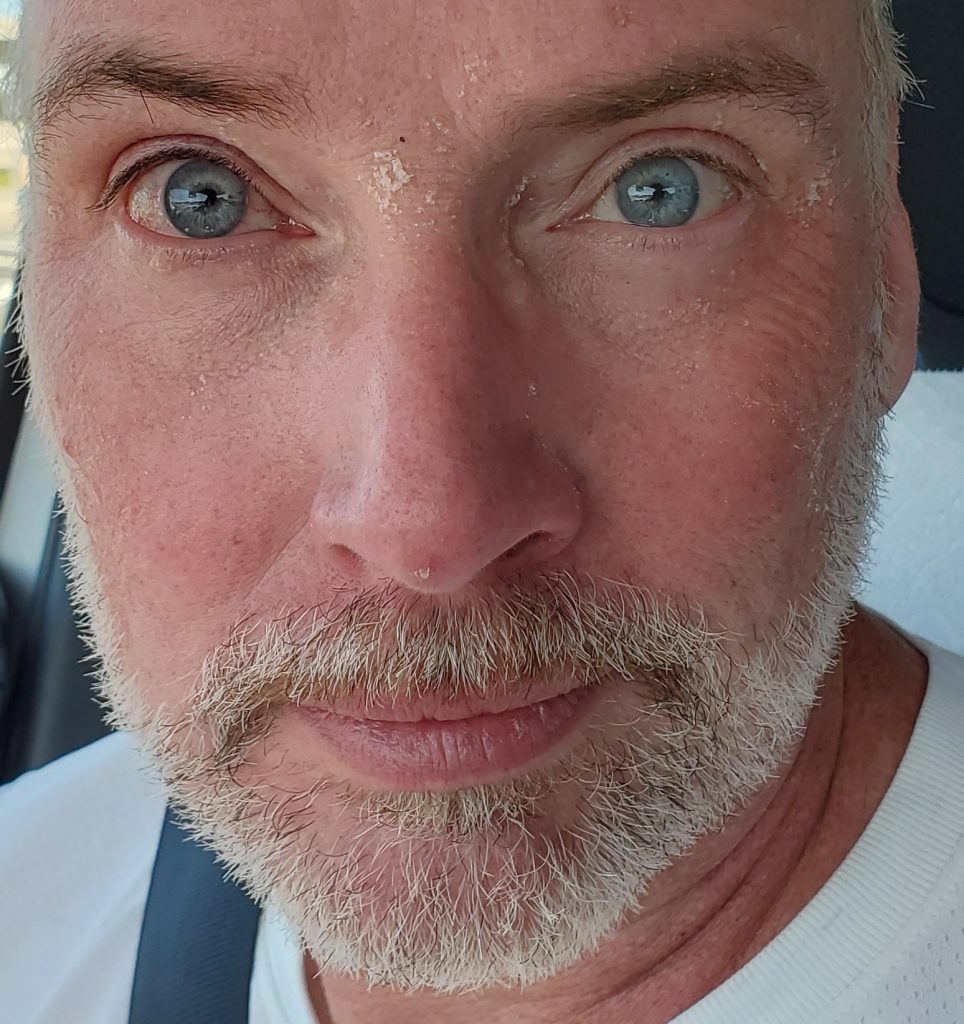
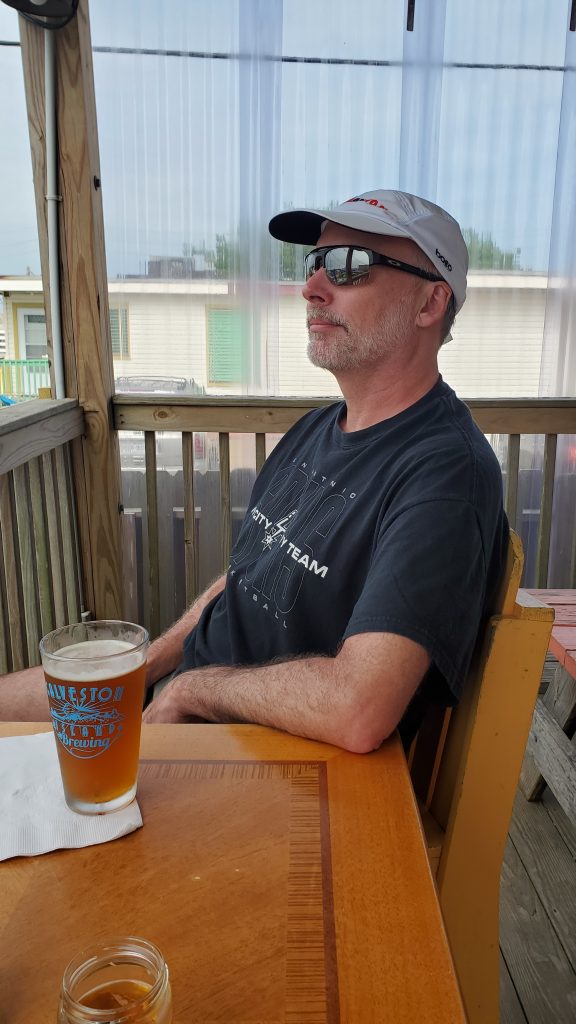
If you’d like to sign up for this event and see me there in 2023 here is a link to: The Official Ironman Site. If you like my writing, please head on over to my author website DavidJoelBush.com and check out the Free Stories link
